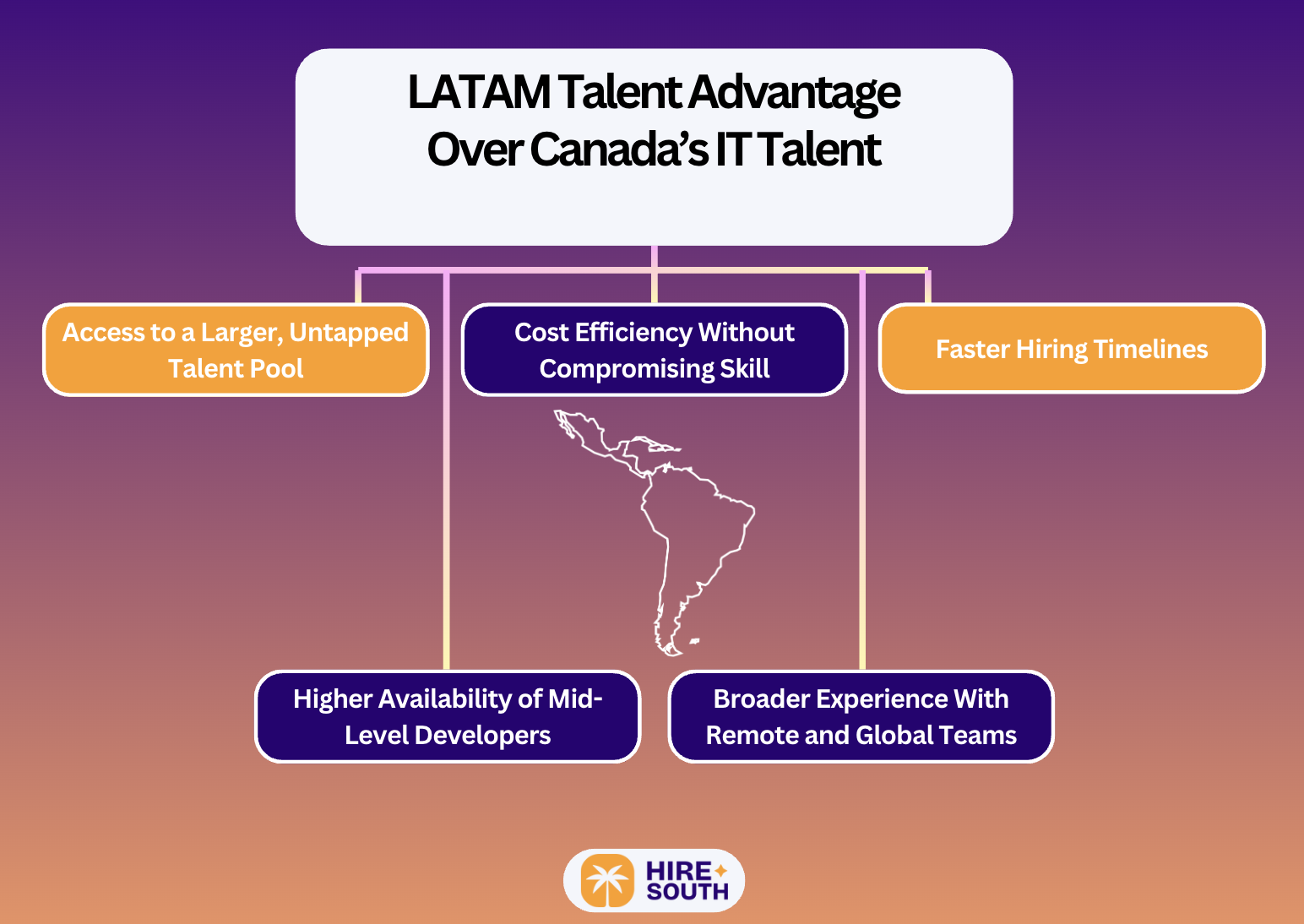Hiring from Latin America is no longer just a US trend, with Canadian companies having long started to catch up. With rising labor costs and a persistent talent gap at home, businesses across Canada are tapping into LATAM’s deep talent pool to stay competitive and scale smarter.
From developers in Brazil to virtual assistants in Colombia, LATAM professionals bring strong English skills, cultural alignment, and cost-effective expertise. And they’re in demand. So much so that tech talent demand in Latin America grew by up to 400% between 2020 and 2023!
This article breaks down why hiring LATAM talent makes sense for Canadian businesses, how it compares to US strategies, and what roles are trending. Ready to know why and how you should hire the best talent south of the border? Keep reading to learn why Canadian businesses hire LATAM talent!
What Makes LATAM Talent Attractive to Canadian Businesses?
Hiring talent from Latin America offers distinct advantages for Canadian employers beyond just cost savings. LATAM professionals often bring a combination of technical skills, adaptability, and cultural alignment that make remote collaboration smoother and more effective.
1. Strong Technical Education and Specialized Skills:
Many LATAM countries have invested heavily in STEM education over the past decade. Brazil, Mexico, Argentina, and Colombia consistently produce top-tier software engineers, designers, and analysts. According to Coursera’s Global Skills Report, LATAM countries rank among the top 25% globally for technology and data science proficiency, with Brazil leading in mobile development and Colombia in cloud computing.
In sectors like software engineering, data analytics, and customer support, candidates from LATAM often have practical experience working with US and Canadian platforms, tools, and standards. This makes onboarding and integration faster.
2. Competitive English Proficiency in Key Markets:
English skills in Latin America have steadily improved, particularly in business and tech hubs. According to the EF English Proficiency Index of 2024, Argentina, Costa Rica, and Chile rank highest in the region, scoring at "High" to "Very High" proficiency levels. Many professionals from these countries are bilingual or functionally fluent in English, reducing communication barriers for Canadian teams.
3. Cultural Fit With Canadian Workplaces:
LATAM professionals tend to align well with North American workplace values, punctuality, accountability, and collaborative problem-solving. Shared work habits and professional norms mean fewer misunderstandings and less time spent on culture-building.
In practical terms, this means smoother workflows, fewer communication breakdowns, and improved remote team dynamics. Especially in service-based roles like customer success or virtual assistance, cultural compatibility can make a measurable impact on performance.
4. Time Zone Compatibility for Real-Time Collaboration:
One of the most overlooked benefits is the time zone overlap. Major cities like Bogotá, Mexico City, and Buenos Aires operate within 1 to 3 hours of Eastern Standard Time. This allows for real-time collaboration with Canadian teams, unlike working with teams in Asia or Eastern Europe.
Daily standups, urgent fixes, and client-facing roles become more manageable when there’s a natural overlap in work hours. For agile teams or departments that rely on synchronous communication, this is a key operational advantage.
5. High Workforce Retention and Motivation:
Unlike some saturated markets, LATAM professionals are often looking for long-term remote roles. High job turnover is less common compared to North America. Many workers in the region see Canadian employers as stable and desirable partners. This increases retention rates and reduces the cost of frequent rehiring or retraining.
A study by Deel revealed that LATAM countries have some of the highest engagement rates among remote hires globally, with Colombia and Argentina leading the list in terms of retention after 12 months.
LATAM Talent’s Advantage Over Local Hires

Access to a Larger, Untapped Talent Pool.
Canada’s tech labor shortage is well-documented. According to the Information and Communications Technology Council (ICTC), Canada will face a shortfall of over 250,000 tech workers by 2025. Meanwhile, Latin America is experiencing a surge in tech education and training. Countries like Brazil, Colombia, and Mexico are graduating tens of thousands of software engineers and IT specialists every year, many of whom are eager for remote roles with North American companies.
This growing pool enables Canadian businesses to scale more quickly without competing heavily for limited local talent. LATAM’s volume provides options, more candidates per open role, faster time-to-hire, and a better role fit.
Cost Efficiency Without Compromising Skill.
Canadian tech salaries have climbed sharply in recent years. The average software engineer in Canada now earns around CAD $95,000–$120,000 annually, according to Randstad Canada. In contrast, highly skilled developers in countries like Argentina or Colombia can be hired for 40% to 60% less, according to Arc.dev’s Global Hiring Guide.
That cost differential also allows for more flexible budgeting in project-based work or longer-term tech support. You can hire senior-level LATAM engineers at the same price point as mid-level Canadian hires, giving you a performance edge.
Faster Hiring Timelines.
In Canada, long hiring cycles are common due to a limited talent pool and high competition, especially in tech hubs like Toronto and Vancouver. According to LinkedIn's Global Talent Trends Report, the average tech role in Canada can take over 40 days to fill.
LATAM hiring timelines are often significantly shorter. Thanks to a high supply of available candidates and well-established remote work practices, roles can be filled in as little as 7 to 14 days. For fast-moving startups or tech teams under pressure, this difference is operationally significant.
Higher Availability of Mid-Level Developers.
Canada’s tech scene is rich in either very senior professionals or junior grads, but there's often a gap in mid-level talent, those with 3 to 7 years of experience. That’s exactly where LATAM talent shines. Due to earlier exposure to global projects and international clients, many LATAM developers hit mid-senior level earlier in their careers.
This sweet spot of experience allows you to onboard someone who doesn’t require extensive training, yet isn’t priced like a senior architect.
Broader Experience With Remote and Global Teams.
Remote work has been the norm across much of LATAM for years. Many professionals are already used to collaborating across time zones and working with clients in North America and Europe. By contrast, many Canadian professionals only transitioned to remote work post-2020 and may still be adapting to distributed workflows.
This remote-native experience means LATAM tech talent often comes with strong asynchronous communication habits, better documentation skills, and the ability to stay productive without micromanagement, qualities that directly impact delivery speed and team cohesion.
How To Make Sure LATAM Talent is the Right Fit for Your Canadian Business?
1. Define the Role Clearly Before Hiring:
Start by outlining what success looks like for the role, skills, responsibilities, tools, time zone availability, and collaboration style. LATAM talent spans a wide range of expertise and backgrounds. Without a detailed role scope, it’s easy to mismatch expectations. Be specific about deliverables, autonomy level, and whether the position is client-facing or internal. This sets the tone for compatibility and avoids misalignment early on.
2. Prioritize Soft Skills and Communication Style:
Even with strong technical skills, communication gaps can slow down projects. Look beyond fluency and assess how candidates explain concepts, ask questions, and respond to feedback. A study by Harvard Business Review found that poor communication accounts for 57% of project failures in remote teams.
During interviews, focus on clarity, tone, and responsiveness. Use async test assignments or ask candidates to document their problem-solving steps. You’re not just hiring talent, you’re hiring a remote collaborator.
3. Align Time Zones and Work Hours:
Most LATAM countries overlap well with Canadian time zones, but not all candidates are available for full North American working hours. Always confirm their preferred working hours and any flexibility they offer.
If the role demands real-time meetings or client interaction, aim for candidates within 2 hours of your team. For project-based work, asynchronous candidates might still be a good fit, just make sure your internal processes support that.
4. Vet Experience With Remote and Global Teams:
Look for professionals with a track record of working across borders. Ask about previous roles involving Canadian, U.S., or European teams. Confirm their experience with tools like Slack, and other remote stack essentials.
The more familiar they are with global team dynamics, the less time you’ll spend onboarding them into your communication rhythm and work culture.
5. Use Structured Trial Periods:
A paid trial project, usually 2 to 4 weeks, can help assess real-world fit without long-term commitment. Test how well they deliver, communicate, and adapt under realistic conditions. Track output, feedback response time, and documentation quality.
This is especially useful when hiring for roles that involve direct collaboration, high autonomy, or strategic input. It also helps spot early red flags in terms of reliability or initiative.
6. Evaluate Cultural Compatibility With Canadian Work Norms:
LATAM professionals generally align well with North American culture, but it’s still smart to check for subtle differences in work style. Ask behavioral questions about autonomy, feedback, deadlines, and conflict resolution.
This matters even more in small or fast-growing teams where culture fit can impact morale and efficiency. Be clear about your expectations around hierarchy, initiative, and transparency.
7. Verify Legal and Compliance Readiness:
Don’t overlook legal eligibility. Confirm whether the candidate prefers freelance, contractor, or EOR employment. If you're unfamiliar with LATAM tax or labor laws, work with a compliance partner to avoid legal risks.
Remote’s 2024 Global Employment Report notes that nearly 70% of companies hiring internationally struggle with local compliance. Ensure your team is prepared to handle the contract structure and payment method required for a smooth working relationship.
8. Check References From Canadian or US Clients:
LATAM professionals with experience working with Canadian or US companies are easier to integrate. Ask for references from previous managers or clients, ideally from a similar business culture.
This gives you better insight into how they’ve performed in comparable environments, and whether they’ve demonstrated adaptability and dependability in the context you’re hiring for.
Ready to Hire LATAM Talent?
Canadian businesses facing a shrinking tech talent pool and rising hiring costs can’t afford to overlook Latin America. With over 1 million highly skilled developers across the region and competitive time zone alignment, LATAM offers a strategic edge for companies seeking to scale efficiently without compromising on quality.
At Hire South, we specialize in helping North American companies navigate the LATAM hiring landscape with precision. From sourcing vetted professionals to managing compliance across borders, our team provides the infrastructure and local insight needed to build reliable, high-performing remote teams. Whether you’re hiring your first LATAM developer or expanding a distributed workforce, we offer the expertise and operational clarity to do it right. Contact us to schedule a free discovery call and make it happen!

Ready to Hire LATAM Talent?
Let us do the legwork to find your perfect remote hire in Latin America!







.svg)